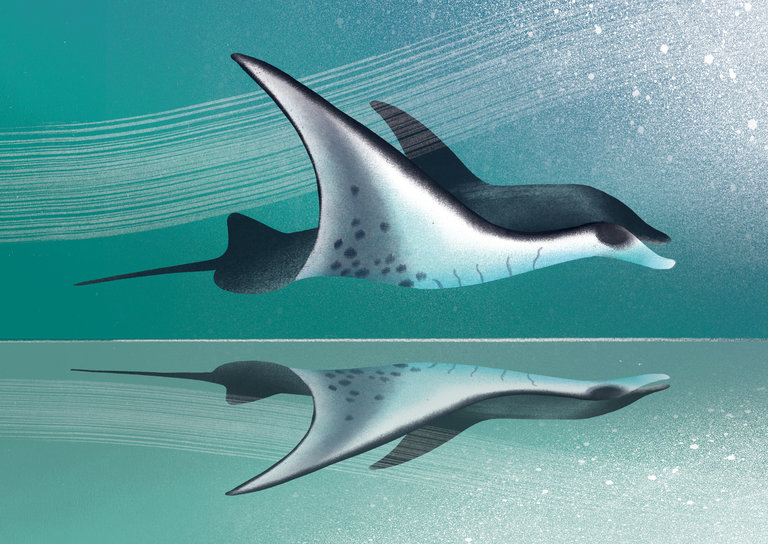Written by Jonathan Balcombe for the New York Times
Washington — IN March, two marine biologists published a study of giant manta rays responding to their reflections in a large mirror installed in their aquarium in the Bahamas. The two captive rays circled in front of the mirror, blew bubbles and performed unusual body movements as if checking their reflection. They made no obvious attempt to interact socially with their reflections, suggesting that they did not mistake what they saw as other rays.
The scientists concluded that the mantas seemed to be recognizing their reflections as themselves.
Mirror self-recognition is a big deal. It indicates self-awareness, a mental attribute previously known only among creatures of noted intelligence like great apes, dolphins, elephants and magpies. We don’t usually think of fishes as smart, let alone self-aware.
As a biologist who specializes in animal behavior and emotions, I’ve spent the past four years exploring the science on the inner lives of fishes. What I’ve uncovered indicates that we grossly underestimate these fabulously diverse marine vertebrates. The accumulating evidence leads to an inescapable conclusion: Fishes think and feel.
Because fishes inhabit vast, obscure habitats, science has only begun to explore below the surface of their private lives. They are not instinct-driven or machinelike. Their minds respond flexibly to different situations. They are not just things; they are sentient beings with lives that matter to them. A fish has a biography, not just a biology.
Those giant manta rays have the largest brains of any fish, and their relative brain-to-body size is comparable to that of some mammals. So, an exception? Then you haven’t met the frillfin goby.
Up to five inches long, with prominent eyes and slightly puffy cheeks looking down on a pouting mouth, the frillfin won’t strike you as an Einstein among fish. But what these humble dwellers of intertidal zones can do with their minds might cause you to reconsider.
At low tide, frillfins hide in rocky tide pools. If danger lurks — a hungry octopus, say — the goby will jump to a neighboring tide pool, with remarkable accuracy. How do they avoid ending up stranded on the rocks?
Continue reading the main story
A series of captive experiments dating from the 1940s found something remarkable. They memorize the tide pool layout while swimming over it at high tide. They can do it in one try, and remember it 40 days later. So much for a fish’s mythic three-second memory.
If a fish’s brain can achieve that, what else might it be capable of?
Tool use was once thought the sole province of humans, but the behavior has now been discovered in a wide range of animals, including fishes. The enterprising orange-dotted tusk fish, a species native to the western Pacific, first uncovers a clam by blowing water on the sand, then carries the mollusk in its mouth to a nearby rock and smashes the clam on the rock with a series of deft head flicks.
This is more than tool use. By using a logical sequence of behaviors, involving several distinct stages, the tusk fish also shows itself to be a planner.
Many fishes hunt cooperatively, as lions do. Last year, I watched from a seaside balcony as a phalanx of predatory fishes made coordinated lunges at a school of herrings they had trapped along a Puerto Rican shoreline. In their desperation to escape, some of the herrings temporarily beached themselves.
On reefs, collaborative hunting has developed an astonishing degree of sophistication. A grouper has been observed inviting a moray eel to join in a foray, communicating by a head-shaking gesture or a full body shimmy. The two fishes probably know each other, for individual recognition is the norm in fish societies.
If the grouper chases a fish into a reef crevice, it uses its body to point to the hidden prey until the slender eel goes after it; if the hapless quarry escapes to open water, the grouper is waiting. Both partners dine more often by working together.
Elsewhere on the reef, small cleaner-fishes make their living by plucking parasites and algae from a variety of so-called client fishes who line up to wait their turn. It’s a snack in exchange for a spa treatment.
A busy cleaner-fish may service hundreds of clients a day. Because some cleaners do a better job than others, waiting clients carefully watch cleaners and rate them: If a cleaner oversteps and nips some mucus from a client’s skin, other clients may go elsewhere for service.
And this in turn explains why cleaner-fishes perform better when they have an audience, and may boost their reputations by caressing clients with their pectoral fins. It’s like Yelp, with kelp.
HOW do we know that being petted feels good to a fish? They ask for it. Friendly groupers swim up to divers to receive strokes, and moray eels will cuddle with trusted divers. Even some shark species love getting face and belly rubs from experienced divers (don’t try this yourself).
And just as it is for us, this kind of attention is therapeutic. In a study of striated surgeonfishes collected from the Great Barrier Reef, researchers stressed their subjects by placing them, one at a time, for 30 minutes in a bucket with just enough water to cover them.
When given the chance, the frazzled surgeonfishes repeatedly sidled up to a realistic mechanical model of a cleaner-fish that was rigged to deliver gentle strokes. Their stress levels — measured as cortisol taken by blood sample — plummeted.
If temporary confinement to a small bucket traumatizes a fish, think what it feels like to be caught. Every year, an estimated half trillion fishes — lined up end to end, they would reach the sun — are hauled up from their habitat. They die by suffocation and crushing in order to provide food for us, our pets and livestock, and even for the fishes we farm. That, or we toss them back, usually dead or dying, as unwanted bycatch.
We have driven many charismatic mammalian species to a point where they’re in peril of extinction. And so it is with many magnificent fish species like cod, swordfish, the Atlantic halibut and the scalloped hammerhead shark.
Since 1960, populations of bluefin tunas — massive, warm-blooded group hunters that can swim up to 50 miles per hour — have declined by 85 percent in the Atlantic and 96 percent in the Pacific.
As innovative research reveals new facets of the private lives of fishes, I’m hopeful that perceptions will change and we’ll show them more mercy. The simplest way to help fishes is to reduce our consumption of them and to source what we do eat from suppliers that adhere to animal welfare standards. As the oceanographer Sylvia Earle, who, like me, no longer eats fish, says: “The ocean has given us so much for so long; it’s time for us to return the favor.”
An Opinion article last Sunday about the intelligence of fishes misidentified the cause of the overfishing of bluefin tuna. Bluefin tuna are harvested for sushi; they are not used by the canning industry.




















